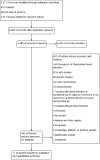The high risk of malarial recurrence in patients with Plasmodium-mixed infection after treatment with antimalarial drugs: a systematic review and meta-analysis
- PMID: 34034802
- PMCID: PMC8145851
- DOI: 10.1186/s13071-021-04792-5
The high risk of malarial recurrence in patients with Plasmodium-mixed infection after treatment with antimalarial drugs: a systematic review and meta-analysis
Abstract
Background: Malaria mixed infections are often unrecognized by microscopists in the hospitals, and a delay or failure to treat Plasmodium-mixed infection may lead to aggravated morbidity and increased mortality. The present study aimed to quantify the pooled proportion and risk of malarial recurrences after the treatment of Plasmodium-mixed infection. The results of the study may provide benefits in the management of Plasmodium-mixed infection in co-endemic regions.
Methods: This systematic review and meta-analysis searched the international Prospective Register of Systematic Reviews (PROSPERO; ID = CRD42020199709), MEDLINE, Web of Science, and Scopus for potentially relevant studies in any language published between January 1, 1936, and July 20, 2020, assessing drug efficacy in patients with Plasmodium-mixed infection. The primary outcome was the pooled prevalence of Plasmodium parasitemia after initiating antimalarial treatment for Plasmodium-mixed infection. The secondary outcome was the pooled risk ratio (RR) of malarial recurrence in Plasmodium-mixed infection compared with those in Plasmodium falciparum and Plasmodium vivax mono-infection. The pooled analyses were calculated by random-effects meta-analysis. After the initial treatment in different days of recurrences (≤ 28 days or > 28 days), the risk of Plasmodium parasitemia was compared in subgroup analysis.
Results: Out of 5217 screened studies, 11 were included in the meta-analysis, including 4390 patients from six countries. The pooled prevalence of all recurrences of Plasmodium-mixed parasitemia was 30% (95% confidence interval (CI) 16-43; I2: 99.2%; 11 studies). The RR of malarial recurrence within 28 days after the initial treatment (clinical treatment failure) of Plasmodium-mixed parasitemia compared with the treatment of P. falciparum was 1.22 (p: 0.029; 95% CI 1.02-1.47; Cochran Q: 0.93; I2: 0%; six studies), while there was no significant difference in the risk of recurrence 28 days after initial treatment compared with the treatment of P. falciparum (p: 0.696, RR: 1.14; 95% CI 0.59-2.18; Cochran Q < 0.05; I2: 98.2%; four studies). The subgroup analysis of antimalarial drugs showed that significant malarial recurrence within 28 days was observed in patients treated with artemisinin-based combination therapies (ACTs) with no significant heterogeneity (p: 0.028, RR: 1.31; 95% CI 1.03-1.66; Cochran Q: 0.834; I2: 0%).
Conclusions: The present findings showed a high prevalence of malarial recurrence after the initial treatment of Plasmodium-mixed infection. Moreover, significant malaria recurrence of mixed infection occurred within 28 days after treatment with ACTs.
Keywords: Artemisinin; Chloroquine; Malaria; Mosquito; Plasmodium; Relapse; Treatment failure.
Conflict of interest statement
The authors declare that there is no conflict of interest regarding the publication of this article.
Figures









Similar articles
-
Risk of Plasmodium vivax parasitaemia after Plasmodium falciparum infection: a systematic review and meta-analysis.Lancet Infect Dis. 2019 Jan;19(1):91-101. doi: 10.1016/S1473-3099(18)30596-6. Lancet Infect Dis. 2019. PMID: 30587297 Free PMC article.
-
The risk of Plasmodium vivax parasitaemia after P. falciparum malaria: An individual patient data meta-analysis from the WorldWide Antimalarial Resistance Network.PLoS Med. 2020 Nov 19;17(11):e1003393. doi: 10.1371/journal.pmed.1003393. eCollection 2020 Nov. PLoS Med. 2020. PMID: 33211712 Free PMC article.
-
In vivo efficacy of anti-malarial drugs against clinical Plasmodium vivax malaria in Ethiopia: a systematic review and meta-analysis.Malar J. 2021 Dec 24;20(1):483. doi: 10.1186/s12936-021-04016-2. Malar J. 2021. PMID: 34952581 Free PMC article.
-
Active case detection, treatment of falciparum malaria with combined chloroquine and sulphadoxine/pyrimethamine and vivax malaria with chloroquine and molecular markers of anti-malarial resistance in the Republic of Vanuatu.Malar J. 2010 Apr 6;9:89. doi: 10.1186/1475-2875-9-89. Malar J. 2010. PMID: 20370920 Free PMC article.
-
Susceptibility of Plasmodium falciparum to artemisinins and Plasmodium vivax to chloroquine in Phuoc Chien Commune, Ninh Thuan Province, south-central Vietnam.Malar J. 2019 Jan 17;18(1):10. doi: 10.1186/s12936-019-2640-2. Malar J. 2019. PMID: 30654808 Free PMC article.
Cited by
-
Towards malaria elimination: a case-control study to assess associated factors to malaria relapses in the extra-Amazon Region of Brazil from 2008 to 2019.Malar J. 2024 Oct 17;23(1):312. doi: 10.1186/s12936-024-05133-4. Malar J. 2024. PMID: 39420377 Free PMC article.
-
A case of an asymptomatic Plasmodium falciparum infection followed by a symptomatic Plasmodium ovale infection in a soldier deployed to South Sudan.Malar J. 2025 Apr 10;24(1):117. doi: 10.1186/s12936-025-05329-2. Malar J. 2025. PMID: 40211377 Free PMC article.
-
Enhanced data quality to improve malaria surveillance in Papua, Indonesia.Malar J. 2025 Jun 4;24(1):177. doi: 10.1186/s12936-025-05358-x. Malar J. 2025. PMID: 40468325 Free PMC article.
-
In pursuit of new anti-malarial candidates: novel synthesized and characterized pyrano-benzodioxepin analogues attenuated Plasmodium berghei replication in malaria-infected mice.Heliyon. 2021 Dec 2;7(12):e08517. doi: 10.1016/j.heliyon.2021.e08517. eCollection 2021 Dec. Heliyon. 2021. PMID: 34934836 Free PMC article.
-
Irrigation-Induced Environmental Changes Sustain Malaria Transmission and Compromise Intervention Effectiveness.J Infect Dis. 2022 Nov 1;226(9):1657-1666. doi: 10.1093/infdis/jiac361. J Infect Dis. 2022. PMID: 36056912 Free PMC article.
References
-
- World Health Organization. Malaria. https://www.who.int/news-room/fact-sheets/detail/malaria. Accessed 20 August 2020.
Publication types
MeSH terms
Substances
Grants and funding
LinkOut - more resources
Full Text Sources
Other Literature Sources
Medical

